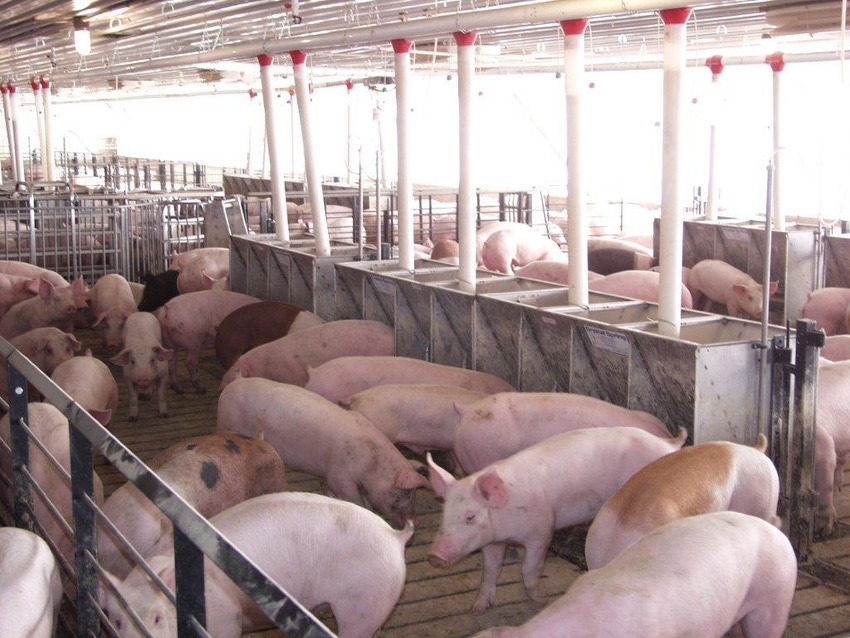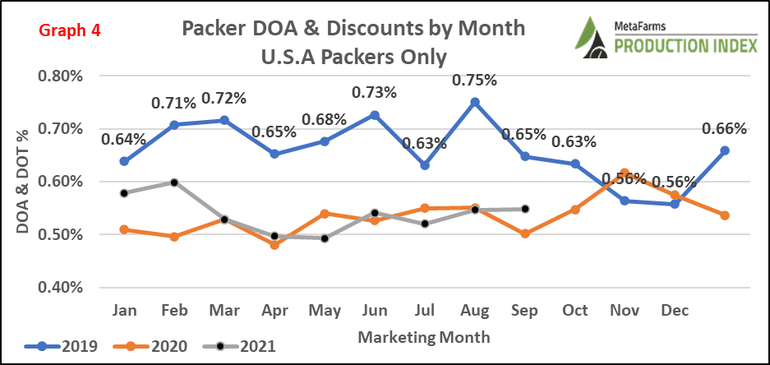One of the most overlooked areas within mortalities is with market sales losses.
November 3, 2021

Ever sense Hernando De Soto, a Spanish explorer, brought the first pig to America in the 1500s, pig health has been one of the leading topics in the pork industry. Pigs can be found in almost every continent, excluding Antarctica, but the diseases and severity of pig losses varies depending upon the continent. In the past few years, Europe and Asia have been challenged with African swine fever (ASF), with whole herds being depopulated. Contrarily, in America, Porcine Reproductive and Respiratory Syndrome (PRRS) has been as challenging to the industry as any other disease, with record level mortalities throughout the production cycle. In this article, the focus will follow and analyze mortalities in every stage of production from the sow farm to wean-to-finish and market sales.
All sow farms and grow finish closeouts are based on a standardized set of business logic and calculation algorithms which allows our analysts and users to make apples-to-apples comparisons of performance across and within companies using MetaFarms Ag Platform.
Chart 1 is a monthly analysis breakdown of the MetaFarms U.S. customer’s sow farms with a focus on sow death loss and pre-wean mortality (PWM%) from January 2019 to current. September 2020 saw the highest death loss (17.2%), whereas November 2020 saw the highest PWM% at 15.3%. Monthly sow mortality average has not been below 14% since November 2019 (22 months). PWM% has fluctuated month-over-month, but the impact of PRRS can be seen with monthly increases historically started in October. It should be noted that the average number of sow farms in this time period would be 370 farms that vary in size between less than 1,000 sows to more than 10,000.

Chart 2 analyzes the last ten years of single-stocked wean-to-finish closeouts broken down into three different percentiles ranges from the best (Top 10%) to the worst (bottom 10%) along with the yearly average. 2021 had the distinction of having each its percentile, along with the average, of being the highest across all years. Each 2021 percentile and average were 0.02-0.33% higher than the next closest month. This is a clear indication that 2021 year has been an above average mortality year but also that it has seen severe mortality closeouts. 2021 closeouts are between January to September.
It is important to understand what makes up a single-stocked wean-to-finish (W2F) group. When determining what a single-stocked group is, MetaFarms looks at percentage of animals transferred out of a group. W2F groups that transferred (pigs moved from one active group to another active group) more than 10%, of the pigs started, are removed from the benchmarking analysis. Removing these groups allows the remaining groups to be compared by performance and costs on a more “apples-to-apples” perspective.

Chart 3 looks at single-stocked wean-to-finish closeouts group average mortality based on the start date of the groups. The purpose of this graph is to analyze the impact of health issues like PRRS that typically flares up historically in October by tracking weaned pigs from entry to marketing. Previous National Hog Farmer articles have been written on the impact of the 2020/2021 PRRS strain 144 Lineage C. W2F closeouts in 2020 and early 2021 dealt with above-average mortality closeouts over previous years.

Chart 4 looks at dead on arrivals (DOA) and discounts for market sales between January 2019 to September 2021. DOAs would be classified as animals that arrived deceased at the plant, while discounts are animals that have been pulled out of the normal lot of pigs that have issues such as a belly hernia, bad leg and so forth. Any market sales lot of less than 50 pigs and a sale from pig cull plants are excluded. Chart 4 below shows DOAs and discounts as a percentage of each sale for the last three years broken down by month. In 2020, there were over 220,000 loads and 38,000,000 pigs included in this data.
2019 was noticeably higher than 2020 and 2021. This analysis is a bright spot for the pork industry in lowering pig losses. The ability for pork producers be to more diligent in sending quality and quantity animals to the packers shows to be paying off.

Pork producers spend millions of dollars to lower pig death losses by using several different production strategies, including filtering sow farms, increased veterinarian oversight and diagnostics analysis. Many companies also have a service team of individuals that will assist daily caregivers in identifying and addressing health concerns.
When I first started on my first sow farm in southern Minnesota over 20 years ago, use antibiotics through injectable or water medication was pretty much standard protocol to treat an unwell pig. As I look back on that time when compared to today, using a product was much more about “do what you feel is right” or “what does it hurt?”. Now, however, caregivers are more educated in identifying sick pigs as well as in addressing the issue with the right medication product at the right time.
Overall, since I started in the pig business, U.S. pork producers have diligently and judicially focused their medication usage, both in the feed and in the water.
Take a moment and really look at the mortality breakdown within your own production system. It is common practice to evaluate sow farm productivity by looking at sow and piglet death or by looking at grow finish losses, but it is important to stop and ask the really hard questions of why and when the mortalities are happening. Common explanations may be circumstances outside of your control. And while those circumstances may be outside of your control, is there anything that can be controlled? Was the ventilation not setup correctly when the pigs first arrived? Was the barn not properly cleaned and disinfected? Was the vaccination protocol followed? Is every pig being properly evaluated every day?
One of the most overlooked areas within mortalities is with market sales losses. Remember that those pigs have a large cost associated with them. Do not lose focus of the little things when marketing, including proper animal handling when loading out, adequate lighting, barn lime in the loadout areas and barn ventilation. Mortalities will always be present but having all involved focus on the little things can lead to big rewards.
MetaFarms Analytic Insights were used to provide the context and trends for this article. If you would like to see an analysis of what your sow to sales mortality was, or if you have suggestions on production areas to write articles about, please e-mail or call us. If you have questions or comments about these columns, or if you have a specific performance measurement that you would like us to write about, please contact Bradley Eckberg.
Sources: Bradley Eckberg, MetaFarms, who are solely responsible for the information provided, and wholly own the information. Informa Business Media and all its subsidiaries are not responsible for any of the content contained in this information asset.
You May Also Like



